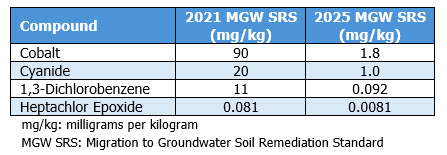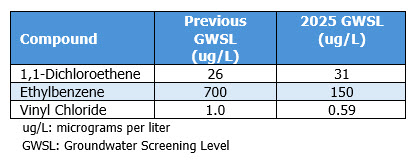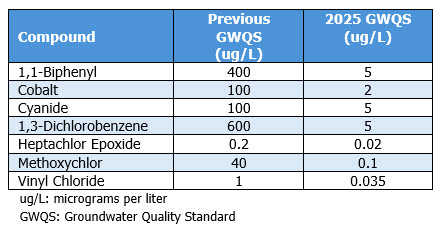Roux Insurance Update: NJDEP Regulatory Changes May Mean Higher Costs and Delays
Authored by: Kaitlin DiGiorgio & Majda Rabah, PhD, PE, LSRP
The New Jersey Department of Environmental Protection (NJDEP) has issued major revisions and announced proposed revisions to several New Jersey Administrative Codes (N.J.A.C.) that could potentially impact environmental remediation timeframes resulting in high cleanup costs. These major revisions include, the NJDEP adoption of revised Soil Remediation Standards (SRS, N.J.A.C 7:26D), Ground Water Quality Standards (GWQS, N.J.A.C. 7:9C), and Ground Water Screening Levels (GWSLs). Additionally, the NJDEP recently published proposed rules to amend the Resilient Environments and Landscapes (REAL) Rule, SRS (N.J.A.C. 7:26D), and GWQS (N.J.A.C. 7:9C).
The many implications of these changes could entail higher costs and delays in cleaning up remediation sites. Below is a summary of the promulgated and proposed changes.
Which rules have been adopted?
- Effective August 4, 2025 – Changes to the Soil and Soil Leachate Remediation Standards: The NJDEP updated the Soil and Soil Leachate Remediation standards for the Migration to Groundwater exposure pathway for 52 compounds. Migration to Groundwater Soil Remediation Standards for four compounds (cobalt, cyanide, 1,3-dichlorobenzene and heptachlor epoxide), decreased by more than an order of magnitude, as shown below:

- Effective August 4, 2025 – Updates to the Coordination of NJDEP and USEPA PCB Remediation Policies: The two most significant changes are the provisions to allow compliance averaging of PCB concentrations exceeding 1 milligram per kilogram (mg/kg) to comply with NJDEP Remediation Standards, and the additional requirements regarding performance-based remediation pursuant to the August 2023 TSCA Rule amendments.
- Effective February 7, 2025 – Lowered/Changed GWSL: The NJDEP lowered the Groundwater Screening Levels for the vapor intrusion pathway for two of the following compounds:

- Effective February 3, 2025 – More Stringent GWQS for 50 Compounds: The NJDEP changed the GWQS (N.J.A.C. 7:9C) for 65 constituents. The GWQS for 50 compounds became more stringent, the GWQS for 13 compounds became less stringent, and interim GWQS for two compounds were developed, summarized below:

What are the proposed regulatory changes?
- July 21, 2025 – REAL Rule Amendments: The NJDEP announced substantial changes to the REAL rules proposed in August 2024, in response to feedback received during the public comment period delaying the adoption of the REAL rules. For more information, review our recent post linked above.
- March 17, 2025 – Technical Requirements for Site Remediation (N.J.A.C. 7:26E): The NJDEP is proposing to add PFAS compounds (GenX, PFNA, PFOA, PFOS), as well as 2,3,7,8-tetrachlorodibenzo-pdioxin (2,3,7,8-TCDD) to the list of regulated contaminants, which would require analysis for any media when contaminants in an area of concern (AOC) are unknown or not well documented.
How will this impact you?
- Existing environmental cases will be required to conduct an order of magnitude evaluation. If an existing case is required to utilize new standards for remediation, the cost and timeline of environmental cleanup may be affected.
- Sites with approved soil or groundwater remedial action permits will be required to conduct an order of magnitude evaluation and an evaluation regarding the historical use of contaminants of emerging concern during the next biennial certification, to ensure the existing remedy remains protective of public health and the environment. This evaluation might result in additional delineation and remediation, which could affect the cost and timeline of the environmental cleanup.
- Changes in land use for closed environmental cases (e.g., a commercial facility to be used as a childcare center) require reassessment of operational history, potential use of emerging contaminants, and the presence of compounds of concern where the remediation standards have changed by an order of magnitude. If investigation at a closed site is triggered due to the promulgation of new standards, or due to the potential historical use of emerging contaminants, then the cost and timeline of environmental cleanup may be affected.
- REAL rules are anticipated to affect property redevelopment and associated land use permitting.
While the impacts appear less than optimal, the Roux team can help you identify impacts and navigate through these substantial changes. Our experts can guide you to take advantage of phase-in provisions, grandfathering sites to less stringent remediation standards. For more information, please contact us below.
